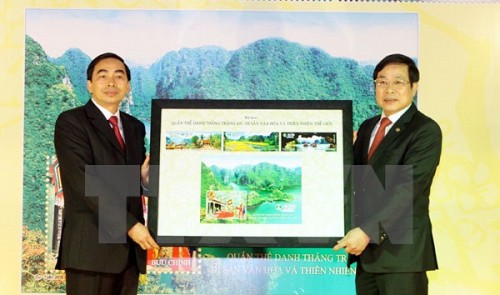Stamps featuring new UNESCO heritage site released
Viet Nam has just released a set of stamps depicting the beauty of UNESCO-recognized Trang An Scenic Landscape Complex and its related festive activities.
The assemblage, “Trang An Scenic Landscape Complex – The World Heritage Site,” was introduced at a recent ceremony to receive a certificate from UNESCO that certifies it as a natural and cultural heritage site.
Located in Ninh Binh Province in northern Viet Nam, the complex was inscribed on UNESCO’s World Heritage List in June 2014.
 |
| Viet Nam has just released a set of stamps depicting the beauty of UNESCO-recognized Trang An Scenic Landscape Complex |
It was the country’s first site to be acknowledged as a mixed natural and cultural property.
The new stamps, created by artists Nguyen Du and Do Lenh Tuan and released by the state-owned Viet Nam Post, measure 62mm x 24mm each.
They depict the grandeur of the complex’s Tam Coc-Bich Dong grottos and Toi (Dark) Cave, as well as the tranquility and gorgeousness of its scenic highlights such as Ngo Dong River and scores of pagodas and temples.
The stamps boast images which vividly conjure up traditional festive activities and rituals including processions to bring water to the temple to King Dinh Tien Hoang (924 – 979), and ceremonial offerings.
The items also highlight the complex’s immense geological value, interaction between humans and the environs, and locals’ adaption to climate change and terrain.
The stamps are to be available on the market from Friday to December 31, 2016.
Nestled on the southern edge of the Red River Delta, Trang An is a resplendent complex of limestone karst peaks which are permeated with valleys, including submerged ones, and surrounded by steep, almost vertical cliffs.
Archaeological traces of human activity dating back almost 30,000 years have been found within the complex.
The Trang An complex boasts several locally-recognized sites like the Trang An ecotourism site, Tam Coc-Bich Dong, Bai Dinh Pagoda, which is the largest of its kind in the country, and Hoa Lu, Viet Nam’s capital in the 10th and 11th centuries.